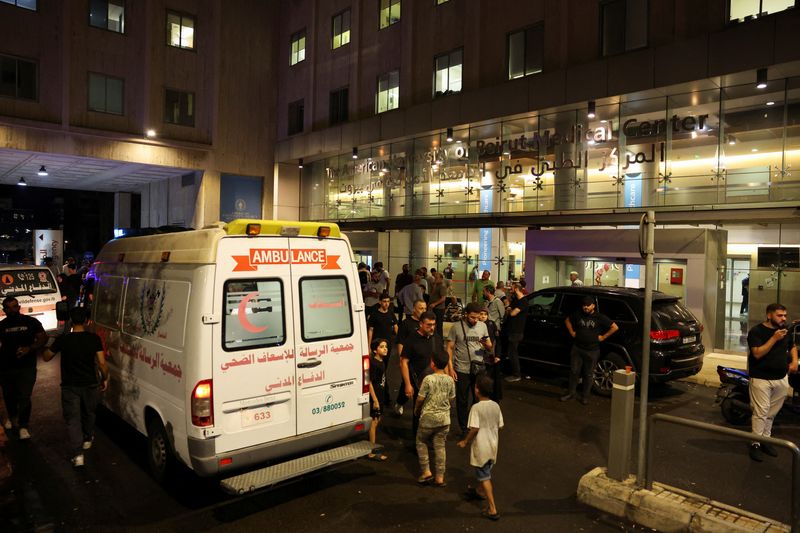Israel planted explosives in Hezbollah’s Taiwan-made pagers, say sources
2024.09.17 21:23
By Laila Bassam and Maya Gebeily
BEIRUT (Reuters) – Israel’s Mossad spy agency planted a small amount of explosives inside 5,000 Taiwan-made pagers ordered by Lebanese group Hezbollah months before Tuesday’s detonations, a senior Lebanese security source and another source told Reuters.
The operation was an unprecedented Hezbollah security breach that saw thousands of pagers detonate across Lebanon, killing nine people and wounding nearly 3,000 others, including the group’s fighters and Iran’s envoy to Beirut.
Iran-backed Hezbollah has vowed to retaliate against Israel, whose military declined to comment on the blasts.
The plot appears to have been many months in the making, several sources told Reuters.
The senior Lebanese security source said the group had ordered 5,000 beepers made by Taiwan-based Gold Apollo, which several sources say were brought into the country earlier this year.
The senior Lebanese security source identified a photograph of the model of the pager, an AP924, which like other pagers wirelessly receive and display text messages but cannot make telephone calls.
Hezbollah fighters have been using pagers as a low-tech means of communication in an attempt to evade Israeli location-tracking, two sources familiar with the group’s operations told Reuters this year.
But the senior Lebanese source said the devices had been modified by Israel’s spy service “at the production level.”
“The Mossad injected a board inside of the device that has explosive material that receives a code. It’s very hard to detect it through any means. Even with any device or scanner,” the source said.
The source said 3,000 of the pagers exploded when a coded message was sent to them, simultaneously activating the explosives.
Another security source told Reuters that up to three grams of explosives were hidden in the new pagers and had gone “undetected” by Hezbollah for months.
Neither Israel nor Gold Apollo immediately responded to Reuters requests for comment.
Images of destroyed pagers analyzed by Reuters showed a format and stickers on the back that were consistent with pagers made by Gold Apollo, based in Taipei.
Hezbollah was reeling from the attack, which left fighters and others bloodied, hospitalised or dead. One Hezbollah official, speaking on condition of anonymity, said the detonation was the group’s “biggest security breach” since the Gaza conflict between Israel and Hezbollah ally Hamas erupted on Oct. 7.
“This would easily be the biggest counterintelligence failure that Hezbollah has had in decades,” said Jonathan Panikoff, the U.S. government’s former deputy national intelligence officer on the Middle East.
BREAK YOUR PHONES, GROUP ORDERED
In February, Hezbollah drew up a war plan that aimed to address gaps in the group’s intelligence infrastructure. Around 170 fighters had already been killed in targeted Israeli strikes on Lebanon, including one senior commander and a top Hamas official in Beirut.
In a televised speech on Feb. 13, the group’s Secretary General Hassan Nasrallah sternly warned supporters that their phones were more dangerous than Israeli spies, saying they should break, bury or lock them in an iron box.
Instead, the group opted to distribute pagers to Hezbollah members across the group’s various branches – from fighters to medics working in its relief services.
The explosions maimed many Hezbollah members, according to footage from hospitals reviewed by Reuters. Wounded men had injuries of varying degrees to the face, missing fingers and gaping wounds at the hip where the pagers were likely worn.
“We really got hit hard,” said the senior Lebanese security source, who has direct knowledge of the group’s probe into the explosions.
The pager blasts came at a time of mounting concern about tensions between Israel and Hezbollah, which have been engaged in cross-border warfare since the Gaza conflict erupted last October.
While the war in Gaza has been Israel’s main focus since the Oct. 7 attack by Hamas-led gunmen, the precarious situation along Israel’s northern border with Lebanon has fueled fears of a regional conflict that could drag in the United States and Iran.
A missile barrage by Hezbollah the day after Oct. 7 opened the latest phase of conflict and since then there have been daily exchanges of rockets, artillery fire and missiles, with Israeli jets striking deep into Lebanese territory.
Hezbollah has said it does not seek a wider war but would fight if Israel launched one.
Israeli Defence Minister Yoav Gallant told U.S. Defense Secretary Lloyd Austin on Monday that the window was closing for a diplomatic solution to the standoff with the Iranian-backed Hezbollah movement in southern Lebanon.
Still, experts said they did not see the pager blasts as a sign that an Israeli ground offensive was imminent.

Instead, it was a sign of Israeli intelligence’s apparently deep penetration of Hezbollah.
“It demonstrates Israel’s ability to infiltrate its adversaries in a remarkably dramatic way,” said Paul Pillar, a 28-year veteran of the U.S. intelligence community, mainly at the CIA.







